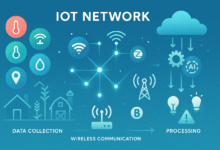Network Slicing Technology: Dedicated IoT Bandwidth Management
Network Slicing Technology transforms IoT networks with smart bandwidth allocation. Get insights on 5G slicing, benefits & practical applications.

The digital world is changing fast, and our internet needs are growing every day. From smart homes to connected cars, billions of devices need reliable internet connections. This is where network slicing technology comes in as a game-changer. Think of it as creating separate digital highways for different types of traffic, ensuring everyone gets the bandwidth they need without traffic jams.
Network slicing technology represents a revolutionary approach to managing network resources. Instead of having one big network trying to handle everything, this technology creates multiple virtual networks within a single physical infrastructure. Each slice is tailored for specific needs, whether it’s for IoT devices, video streaming, or emergency services.
What is Network Slicing Technology?
Network slicing technology is like having multiple lanes on a highway, but each lane is designed for different types of vehicles. In the digital world, these “lanes” are virtual networks that share the same physical infrastructure but operate independently. Each network slice has its own set of resources, security protocols, and performance characteristics.
This technology became essential with the rise of 5G networks and the Internet of Things (IoT). Traditional networks treated all data the same way, but modern applications have vastly different requirements. A smart thermostat doesn’t need the same bandwidth as a live video call, and emergency services need guaranteed connectivity that personal browsing doesn’t require.
The beauty of network slicing lies in its flexibility. Network operators can create, modify, or delete slices based on demand. This dynamic approach ensures optimal resource utilization while meeting diverse service requirements. It’s like having a smart traffic control system that can instantly create new lanes when needed and remove them when traffic is light.
How Network Slicing Works in IoT Environments
IoT bandwidth management becomes much more efficient with network slicing technology. IoT devices typically generate small amounts of data but require reliable, low-latency connections. Traditional networks often struggle to handle the massive number of IoT connections while maintaining quality for other services.
Network slicing solves this problem by creating dedicated slices for IoT traffic. These slices are optimized for the specific characteristics of IoT communication: low power consumption, occasional data transmission, and the need for wide coverage. The technology can automatically adjust resources based on the number of active IoT devices and their data requirements.
For example, a smart city might have different slices for traffic lights, environmental sensors, and parking meters. Each slice operates independently, so if one experiences issues, it doesn’t affect the others. This isolation ensures that critical infrastructure remains operational even during network problems.
The slicing technology also enables better security for IoT devices. Each slice can have its own security protocols, protecting sensitive IoT data from potential threats in other network segments. This is particularly important for industrial IoT applications where security breaches could have serious consequences.
Benefits of Network Slicing for Bandwidth Management
Network slicing technology offers numerous advantages for managing bandwidth effectively. The most significant benefit is improved network efficiency. By allocating resources dynamically based on actual needs, operators can serve more users and applications without upgrading physical infrastructure.
Quality of service becomes predictable and guaranteed with network slicing. Critical applications can receive dedicated bandwidth that’s always available, regardless of network congestion elsewhere. This is crucial for applications like autonomous vehicles or medical devices that require consistent, reliable connectivity.
Cost reduction is another major advantage. Instead of building separate physical networks for different services, operators can create multiple virtual networks on existing infrastructure. This approach significantly reduces capital and operational expenses while providing better service flexibility.
The technology also enables new business models. Service providers can offer customized network services tailored to specific customer needs. A manufacturing company might pay for a dedicated slice with ultra-low latency, while a content provider might choose a slice optimized for high-bandwidth video delivery.
Network slicing technology improves scalability as well. Adding new services or expanding existing ones becomes much easier when you can create new virtual networks instead of building physical infrastructure. This scalability is essential for supporting the growing number of connected devices and emerging technologies.
Implementation Challenges and Solutions
While network slicing technology offers many benefits, implementing it comes with challenges. The complexity of managing multiple virtual networks simultaneously requires sophisticated orchestration systems. These systems must coordinate resource allocation, monitor performance, and maintain security across all slices.
Legacy infrastructure compatibility presents another challenge. Many existing networks weren’t designed with slicing in mind, requiring significant upgrades or workarounds to support the technology. This transition period can be costly and technically demanding for network operators.
Security becomes more complex with multiple network slices. Each slice needs its own security measures, and operators must ensure that problems in one slice don’t compromise others. This requires advanced security monitoring and isolation techniques that many organizations are still developing.
Resource optimization across slices requires careful planning and continuous monitoring. Operators must balance competing demands for bandwidth, processing power, and storage while maintaining service quality for all slices. This balancing act becomes more challenging as the number of slices and their complexity increases.
Training and skill development represent additional challenges. Network engineers need new skills to design, implement, and manage sliced networks effectively. The technology involves concepts and tools that differ significantly from traditional networking approaches.
Real-World Applications and Use Cases
Smart cities represent one of the most compelling applications of network slicing technology. Different city services require different network characteristics: traffic management systems need reliable, low-latency connections, while environmental monitoring can tolerate some delay but requires wide coverage. Network slicing allows cities to optimize their network infrastructure for each application type.
Healthcare applications benefit enormously from dedicated network slices. Medical devices require guaranteed bandwidth and ultra-reliable connections. Network slicing technology can provide dedicated slices for telemedicine, patient monitoring, and emergency services, ensuring these critical applications always have the connectivity they need.
Manufacturing and industrial IoT applications use network slicing to create isolated, secure networks for their operations. These slices can be customized for specific industrial processes, providing the exact performance characteristics needed while maintaining security and isolation from other network traffic.
Autonomous vehicles represent a future application where network slicing will be essential. These vehicles need ultra-low latency communication for safety-critical functions, high bandwidth for map updates and entertainment, and reliable connectivity for basic operational data. Network slicing can provide all these requirements simultaneously.
Entertainment and media streaming services use network slicing to ensure consistent quality for their users. Dedicated slices for video content can prioritize bandwidth and optimize delivery paths, providing better streaming quality even during peak usage periods.
Future of Network Slicing Technology
The future of network slicing technology looks incredibly promising as more organizations recognize its potential. 6G networks, currently in development, are being designed with advanced slicing capabilities from the ground up. These next-generation networks will support even more sophisticated slicing scenarios with better automation and intelligence.
Artificial intelligence and machine learning are being integrated into network slicing systems to enable autonomous slice management. These smart systems will be able to predict demand, optimize resource allocation, and automatically create or modify slices based on changing conditions.
Edge computing integration represents another exciting development. Network slicing technology will work closely with edge computing infrastructure to provide ultra-low latency services. This combination will enable new applications like augmented reality and real-time industrial automation.
The technology is also evolving to support cross-domain slicing, where network slices can span multiple network operators or technologies. This capability will enable truly global services with consistent quality and performance characteristics regardless of location or underlying infrastructure.
Standards development continues to advance, with organizations worldwide working to ensure interoperability between different slicing implementations. These standards will make it easier for organizations to adopt the technology and for vendors to develop compatible solutions.
Best Practices for Implementation
Successful network slicing implementation requires careful planning and a phased approach. Organizations should start by identifying their specific use cases and requirements before designing their slicing strategy. This assessment helps determine the number and types of slices needed and their resource requirements.
Choosing the right technology partners is crucial for successful implementation. Organizations need vendors with proven experience in network slicing and the ability to provide ongoing support. The complexity of the technology makes vendor expertise and support capabilities critical success factors.
Staff training and change management are essential components of any network slicing project. Technical teams need training on new concepts and tools, while business teams need to understand the capabilities and limitations of the technology. This education ensures that the organization can effectively use and manage their sliced network infrastructure.
Monitoring and analytics capabilities must be built into the system from the beginning. Network slicing creates new visibility challenges, and organizations need sophisticated tools to monitor performance, security, and resource utilization across all slices. These monitoring capabilities enable proactive management and optimization.
Security planning requires special attention in sliced networks. Organizations must develop comprehensive security strategies that address the unique challenges of managing multiple virtual networks. This includes access controls, monitoring systems, and incident response procedures tailored for sliced environments.
Economic Impact and Business Benefits
Network slicing technology creates significant economic opportunities for both service providers and their customers. Operators can generate new revenue streams by offering specialized network services tailored to specific industry needs. This differentiation helps them compete more effectively and justify premium pricing for enhanced services.
For businesses, network slicing technology enables more efficient operations and new capabilities that weren’t possible with traditional networks. Companies can optimize their network costs by paying only for the specific performance characteristics they need, rather than over-provisioning to handle peak demands.
The technology also enables faster time-to-market for new services and applications. Instead of waiting for new infrastructure deployment, organizations can quickly create new network slices to support their innovations. This agility provides competitive advantages in fast-moving markets.
Cost savings from shared infrastructure benefit everyone in the ecosystem. By enabling multiple services to share physical network resources efficiently, network slicing technology reduces the overall cost of connectivity while improving service quality. These savings can be passed on to end users or reinvested in further network improvements.
Innovation acceleration is another economic benefit of network slicing technology. The ability to quickly create customized network environments encourages experimentation and development of new applications and services. This innovation cycle drives economic growth and technological advancement across industries.
Conclusion
Network slicing technology represents a fundamental shift in how we think about and manage network resources. By creating dedicated virtual networks within shared physical infrastructure, this technology enables unprecedented flexibility, efficiency, and service customization. The benefits for IoT bandwidth management are particularly significant, as the technology addresses the unique challenges of connecting billions of diverse devices.
The implementation challenges are real but manageable with proper planning, expertise, and commitment. Organizations that successfully adopt network slicing technology will gain significant competitive advantages through improved network performance, reduced costs, and the ability to offer innovative services.
As the technology continues to evolve with advances in AI, edge computing, and next-generation networks, its importance will only grow. Network slicing technology is not just a technical innovation; it’s an enabler of the digital transformation that’s reshaping industries and society. Organizations that understand and embrace this technology today will be best positioned to thrive in tomorrow’s connected world.
The future of networking is sliced, and that future is arriving faster than many realize. Whether you’re a network operator, business leader, or technology professional, understanding network slicing technology and its implications is essential for success in our increasingly connected world.











